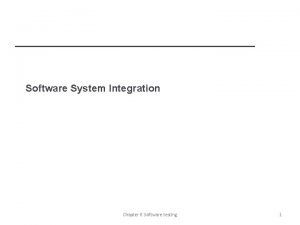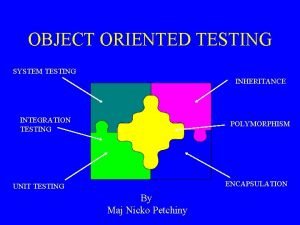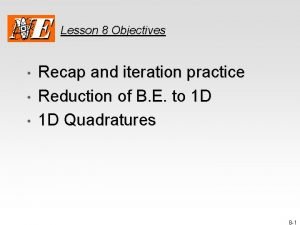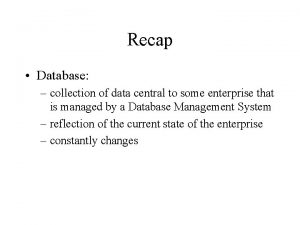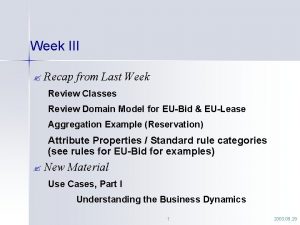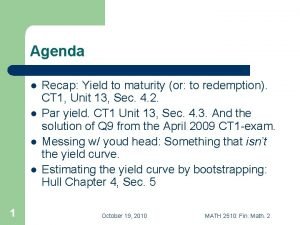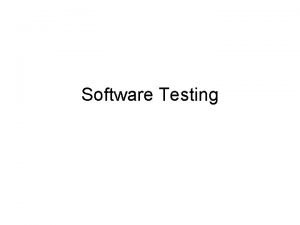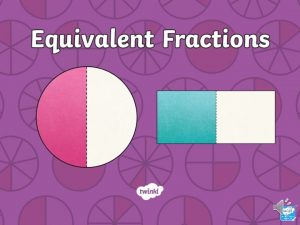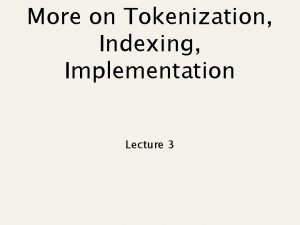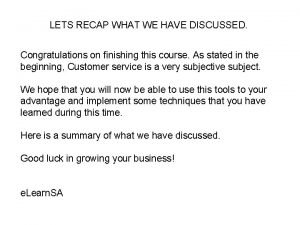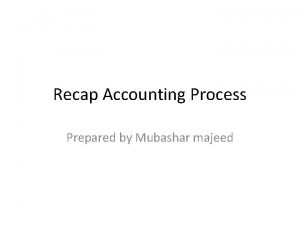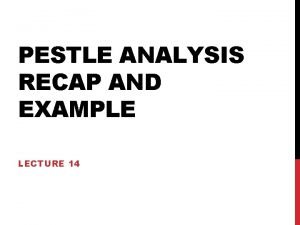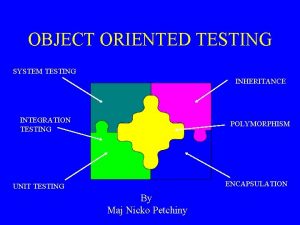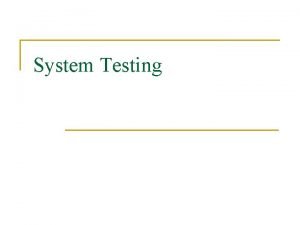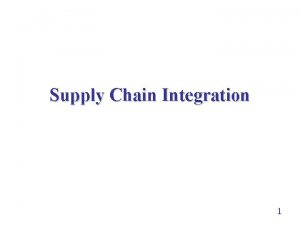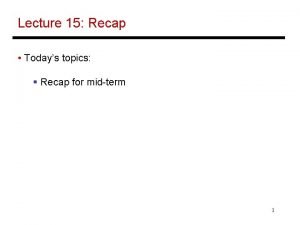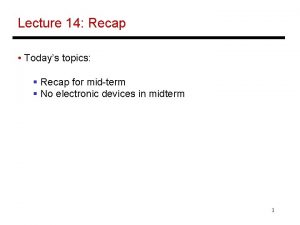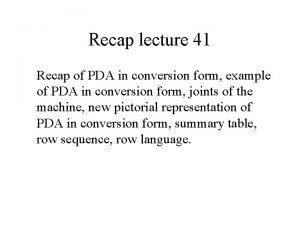System Testing Outline Recap testing system Integration testing
































- Slides: 32

System Testing

Outline • Recap: testing system • Integration testing • Performance testing 2

recap system testing

System testing • System testing: tests the behavior of a system as a whole, with respect to scenarios and requirements • Functional testing, integration testing • Load, stress, performance testing • Acceptance, usability, installation, beta testing 4

System testing • System testing: tests the behavior of a system as a whole, with respect to scenarios and requirements • Functional testing, integration testing • Load, stress, performance testing • Acceptance, usability, installation, beta testing 4

test integration testing

Integration testing • Integration testing: checking software quality by testing two or more dependent software modules as a group or a (sub)system. • Challenges same as in unit testing, plus: • Combined units can fail in more places and in more complicated ways. • How to test a partial system where not all parts exist? • How to "rig" the behavior of unit A so as to produce a given behavior from unit B? 6

Stubs: a way to test a partial system • Stub: A controllable replacement for an existing software unit to which your code under test has a dependency. • Useful for simulating difficult-to-control elements: • network / internet • time/date-sensitive code • database, files, io, threads, memory • brittle legacy code /systems 7

Testing with stubs (1/3) • Identify the external dependency. • This is either a resource or a class/object. • If it isn't an object, wrap it up into one. • (Suppose that Class A depends on Class B. ) 8

Testing with stubs (2/3) • Extract the core functionality of the object into an interface. • Create an Interface. B based on B • Change all of A's code to work with type Interface. B, not B 9

Testing with stubs (3/3) • Write a second "stub" class that also implements the interface, but returns pre- determined fake data. • Now A's dependency on B is abstracted away and can be tested easily. • Can focus on how well A integrates with B's external behavior. 10

Where to inject stubs? • Seams: places to inject the stub so Class A will talk to it. • at construction (not ideal) A aardvark = new A(new Stub. B()); • through a getter/setter method (better) A apple = new A(. . . ); aardvark. set. Resource(new Stub. B()); • just before usage, as a parameter (also better) aardvark. method. That. Uses. B(new Stub. B()); • You should not have to change A's code everywhere (beyond using your interface) in order to use your Stub B. (a "testable design") 11

Mock objects: a way to test interactions • Mock object: A fake object that decides whether a unit test has passed or failed by watching interactions between objects. • Useful for interaction testing, as opposed to state testing 12

Stubs vs mocks • A stub (B) gives out data that goes to the object/class under test (A). • The unit test directly asserts against A, to make sure it gives the right result when fed B’s data. class under test (A) communicat e stub (B) asse rt test 1 3

Stubs vs mocks • A stub (B) gives out data that goes to the object/class under test (A). • The unit test directly asserts against A, to make sure it gives the right result when fed B’s data. • A mock (B) waits to be called by the class under test (A). • It may have several methods it expects that A should call. • It makes sure that it was called in exactly the right way. • If A interacts with B the way it should, the test passes. class under test (A) communicat e asse rt test stub (B) class under test (A) communicat e mock (B) asse rt test 1 3

Mock object frameworks • Stubs are often best created by hand/IDE. Mocks are tedious to create manually. • Mock object frameworks help with the process. • android-mock, Easy. Mock, j. Mock (Java) • . . . • Frameworks provide the following: • auto-generation of mock objects that implement a given interface • logging of what calls are performed on the mock objects • methods/primitives for declaring and asserting your expectations 14

A j. Mock example import org. jmock. integration. junit 4. *; import org. jmock. *; @Run. With(JMock. class) public class Class. ATest { private Mockery mockery // // Assumes that we are testing class A's calls on B. = new JUnit 4 Mockery(); // initialize j. Mock @Test public void test. ACalls. BProperly 1() { // create mock object to mock Interface. B final Interface. B mock. B = mockery. mock(Interface. B. class); // construct object from A aardvark = new A(. . . ); aardvark. set. Resource(mock. B); class under test; attach to mock // declare expectations for how mock should be used mockery. checking(new Expectations() {{ one. Of(mock. B). method 1("an expected parameter"); will(return. Value(0. 0)); one. Of(mock. B). method 2(); }}); // } } execute code A under test; should mock. B aardvark. method. That. Uses. B(); lead to calls on // assert that A behaved as expected mockery. assert. Is. Satisfied(); 15

Using stubs and mocks together 1 6

Using stubs and mocks together • Suppose a log analyzer reads from a web service. If the web fails to log an error, the analyzer must send email. 1 6

Using stubs and mocks together • Suppose a log analyzer reads from a web service. If the web fails to log an error, the analyzer must send email. • How to test to ensure that this behavior is occurring? • Set up a stub intentionally fails. for the web service that • Set up a mock log. Error(Strin for the email service that checks to see whether the it to send an Stub. Web. Service Log. Analyzer g) analyzer contacts email message. send. Email () test asse rt Mock. Email. Sende r 1 6

test performance testing

Acceptance, performance • Acceptance testing: System is shown to the user / client / customer to make sure that it meets their needs. • A form of black-box system testing. • Performance is important. • Performance is a major aspect of program acceptance by users. • Your intuition about what's slow is often wrong. Premature optimization is the root of all evil. Donald Knuth 18

Thinking about performance 1 9

Thinking about performance • The app is only too slow if it doesn't meet your project’s stated performance requirements. • If it meets them, DON'T optimize it! 1 9

Thinking about performance • The app is only too slow if it doesn't meet your project’s stated performance requirements. • If it meets them, DON'T optimize it! • Which is more important, fast code or correct code? 1 9

Thinking about performance • The app is only too slow if it doesn't meet your project’s stated performance requirements. • If it meets them, DON'T optimize it! • Which is more important, fast code or correct code? • What are reasonable performance requirements? • What are the user's expectations? How slow is "acceptable" for this portion of the application? • How long do users wait for a web page to load? • Some tasks (admin updates database) can take longer 1 9

Profile and measure before optimizing • Runtime / CPU usage • what lines of code the program is spending the most time in • what call/invocation paths were used to get to these lines • Memory usage • what kinds of objects are on the heap • where were they allocated • who is pointing to them now • "memory leaks" (does Java have these? ) • Web page load times, requests/minute, … 2 0

Profile and measure before optimizing • Runtime / CPU usage • what lines of code the program is spending the most time in • what call/invocation paths were used to get to these lines CPU profiling slows down your code (a lot). Desig n your profiling tests to be very short. • Memory usage • what kinds of objects are on the heap • where were they allocated • who is pointing to them now • "memory leaks" (does Java have these? ) • Web page load times, requests/minute, … 2 0

Optimization hints: think high-level 2 1

Optimization hints: think high-level • Focus on high-level optimizations (algorithms, data structures) • Leave the low-level ones to the compiler 2 1

Optimization hints: think high-level • Focus on high-level optimizations (algorithms, data structures) • Leave the low-level ones to the compiler • Some common high-level optimizations • Lazy evaluation saves you from computing/loading • don't read / compute things until you need them • Hashing, caching save you from reloading resources • combine multiple database queries into one query • save I/O / query results in memory for later Web page load times, requests/minute, etc. • Precomputing values and storing them in a lookup table • the first 1000 primes 2 1

Summary • System testing checks the behavior of a system as a whole. • Integration testing checks software quality by testing two or more dependent software modules as a group. • Performance testing checks that a system meets performance requirements (e. g. , responsiveness). 2 2
 Recap coordinate system
Recap coordinate system Forward integration and backward integration
Forward integration and backward integration Vertical integration
Vertical integration Simultaneous integration
Simultaneous integration System integration testing checklist
System integration testing checklist Object oriented integration and system testing
Object oriented integration and system testing Shawshank redemption brief summary
Shawshank redemption brief summary Sparknotes great gatsby chapter 8
Sparknotes great gatsby chapter 8 Price is right recap
Price is right recap What is the purpose of an iteration recap
What is the purpose of an iteration recap Recap intensity clipping
Recap intensity clipping 60 minutes recap
60 minutes recap Recap database
Recap database Bracket power rule
Bracket power rule Sample script for recapitulation
Sample script for recapitulation Recap introduction
Recap introduction Recap from last week
Recap from last week The crucible symbols
The crucible symbols The crucible act 1 recap
The crucible act 1 recap Logbook recap example
Logbook recap example Ytm recap
Ytm recap Black box recap
Black box recap Fractions recap
Fractions recap Recap
Recap Recap indexing scans
Recap indexing scans Let's have a quick recap
Let's have a quick recap Recap poster
Recap poster What is an essay
What is an essay Ldeq recap
Ldeq recap Scene
Scene Recap accounting
Recap accounting What is economic environment example
What is economic environment example Let's recap
Let's recap




